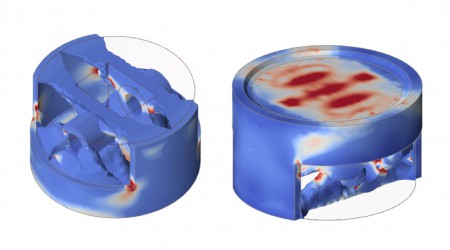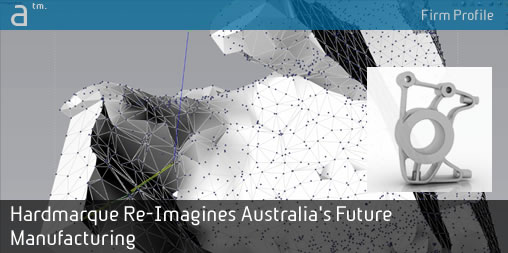Nick Hardman speaks steadily with a sturdy, hybrid Australian—New Zealand accent and quickly comes across as a guy who doesn’t waste time getting to the point. He’s also curious, knows what it takes to build stuff, and above all passionate about the future of Hardmarque, his two-pronged business in industrial design and manufacturing. This past fall I had a chance to talk to him (in his morning and my evening) about both sides to this business, and in particular about his use of solidThinking Evolve and solidThinking Inspire to help ignite the 3D printing and nascent ‘additive manufacturing’ movement in Australia.
As someone who has been around in the construction and manufacturing management world, Hardman has solid knowledge about the general happenings of Australia’s big manufacturing world, which has been losing ground to nearby Asian countries who can provide global scale at lower costs. As Australia shifts—like so many other countries around the world—to reflect changing global manufacturing dynamics, Hardman has positioned himself, interestingly, on the perch of a nascent ‘additive manufacturing’ movement. As an industrial designer with experience in 3D printing of parts, he has also become a solidThinking expert and a channel for that company in Australia.
The Interview
AFR (Anthony Frausto-Robledo): Nick, how did you get started with HardMarque Future Design and Future Factories?
NH (Nick Hardman): Well my background is in industrial design and I lost my job a couple of years ago—it was a job in construction management. I just realized that I was drifting further away from my core. So I decided to try to get back into it. And I decided I’d start out on my own; it was seen as the only way to maybe break through. So that’s the origin of HardMarque.
AFR: Were you doing any industrial design work while you were working in the construction world?
NH: Just before I finished up I was. I was asked by my boss to design something, a part. And he wanted to buy a 3D printer and test it out and potentially make it. So we designed and went through the prototyping process. Unfortunately the project got shut down. So that little project didn’t see the light of day but I guess I carried on the idea of 3D printing from that little exercise.

01 – Image showing the piston designed by Nick Hardman of Hardmarque Design, industrial design using solidThinking Inspire and solidThinking Evolve. (image courtesy of Hardmarque, All rights reserved.)
AFR: How long did take you to get back into industrial design? I’m assuming you were likely out of it for awhile while working in management in the construction industry.
NH: Right. Well, I’m originally from New Zealand and that’s where I studied. And there is no industry there to speak of in terms of industrial design or manufacturing. So the only jobs I could start at after college were junior level quality assurance and management jobs. I got a job with a large manufacturer and they were quite specialized. That was my first experience in management and I just moved onto increasing levels in management. And then when I moved to Australia I got a job for a company specializing in ETFE roofing systems. If you are familiar with the Beijng Aquatic Center for the Olympics in China—the building was covered in essentially bubbles—I was working for that company.
From National Lab to Additive Manufacturing
AFR: How did you get your start in additive manufacturing and 3D printing?
NH: Within the first year of starting up my little company I met this guy who worked for CSIRO (Commonwealth, Scientific Industrial Research Organization) here in Australia. It’s a bit like Oak Ridge National labs in the states.
He was an American actually, from Lockheed Martin, and he was running the newly established additive manufacturing department. I got in contact with him over LinkedIn and I told him I was an industrial designer interested in additive manufacturing, and asked whether we could meet up and have a chat over coffee. He agreed.
Anyway, he asked me a bit later to redesign a brake caliper for additive, as a case study for a local brake manufacturer. And that’s how it really got started.
AFR: Can you explain to me what ‘additive manufacturing’ is?
NH: Okay. So let’s take the piston as an example. (see images 01 – 02) Traditionally, you would take a big lump of metal, stick it in a CNC mill, and cut away material lots of material to get the shape of the final product. That’s called subtractive manufacturing, you remove material to get the net shape. Additive manufacturing is the opposite, you start with a fine metal powder and use a laser beam or an electron beam to melt successive slices, or cross-sections, of the part on top of each other.

02 – Nick Hardman’s piston design is being partially generated within solidThinking Inspire using its unique metamorphosis technology which positions material matter where it is needed to resist forces and loads. The result are unique organic-shaped designs that are lighter than traditional design approaches yet just as strong.
So if you can imagine a CT scan or an MRI scan of a person how it takes cross-sectional views of the human body, if you were to laminate those sections together you would have the full three dimensional body. So that’s basically what additive manufacturing is.
AFR: I take it the laser is guiding some kind of part that is providing the source of the metal itself.
NH: Yes, if you can image a moveable platform inside a box and a laser/electron gun pointing down onto the platform, this is essentially what a 3D printer is. The printing process involves a rake that sweeps over the platform to deposit a very thin layer of metal powder on it. Then the laser/electron gun draws a slice of the part on the powder, melting it as it goes, and once complete the platform moves down by one layer’s thickness (25-50 microns) for the process to repeat. This continues until eventually the entire part is built.
next page > Australia’s Manufacturing and solidThinking’s Inspire and Evolve





Reader Comments
#CAD Firm Profile: Nick Hardman—Hardmarque Re-Imagines Australia’s Future Manufacturing http://t.co/p8ENUqX0V0
#CAD Firm Profile: Nick Hardman—Hardmarque Re-Imagines Australia’s Future Manufacturing http://t.co/p8ENUqX0V0
Firm Profile: Nick Hardman—Hardmarque Re-Imagines Australia’s Future Manufacturing http://t.co/ExWhNuMqpZ via @architosh
Firm Profile: Nick Hardman—Hardmarque Re-Imagines Australia’s Future Manufacturing http://t.co/ExWhNuMqpZ via @architosh
http://t.co/YFlfxdhIMY — learn about “additive manufacturing” printing 3D parts and solidThinking in MCAD-design
Firm Profile: Nick Hardman—Hardmarque Re-Imagines Australia’s Future Manufacturing @vicgasco @Trede3D http://t.co/UqvR5aZ43Y
Firm Profile: Nick Hardman—Hardmarque Re-Imagines Australia’s Future Manufacturing @vicgasco @Trede3D http://t.co/UqvR5aZ43Y
http://t.co/YFlfxdhIMY — learn about “additive manufacturing” printing 3D parts and solidThinking in MCAD-design
RT @architosh http://t.co/v36VX3OKWw — learn about “additive manufacturing” printing 3D parts and solidThinking in MCAD-design
RT @architosh http://t.co/v36VX3OKWw — learn about “additive manufacturing” printing 3D parts and solidThinking in MCAD-design
RT @3dprint_news: RT @architosh http://t.co/v36VX3OKWw — learn about “additive manufacturing” printing 3D parts and solidThinking in MCAD-…
RT @3dprint_news: RT @architosh http://t.co/v36VX3OKWw — learn about “additive manufacturing” printing 3D parts and solidThinking in MCAD-…
Comments are closed.